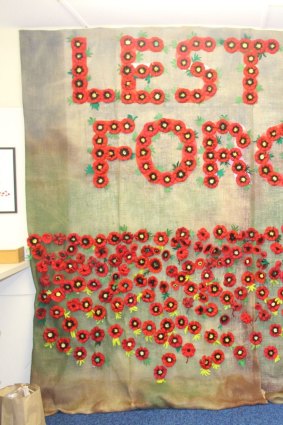By Ian Warden
It takes a very special, very magical sound to make even a statue prick up its ears and turn its head to listen but your columnist saw this happen (trust me, I'm a journalist) on Friday in the sculpture garden of the Australian War Memorial.
The statue was the famous bust of Bellona the Goddess of War and the sound that beguiled her was created by distinguished trumpeter Paul Goodchild playing an old cornet that 100 years ago was played on Gallipoli. Goodchild, himself touched and beguiled by the opportunity to play an instrument with such semi-sacred provenance, said that playing it "feels like going out to bat with Sir Donald Bradman's bat".

Paul Goodchild plays the Gallipoli cornet. Credit: Kat Southwell
For the media, and for nearby Bellona, Goodchild played a soft and melancholy piece called The Rosary, full of nuances. The very last note seemed to take for ever to fade away. Bellona's bronze eyes filled with wonder.
This was on Friday and outdoors but at Sunday's Sunday's Resounding Gallipoli - music from the campaign concert the High Court (blessed with a cathedral-like acoustic) resounded to this very cornet that was played on Gallipoli. Words cannot wield the matter of the strangeness of us, today, in comfortable Canberra, listening to sounds that were listened to by our men at war in 1915. Other authentic Gallipoli sounds of 1915 that resounded around the High Court on Sunday came from the blowing of actual trench whistles (belonging now to the Australian War Memorial) used on Gallipoli to send men into attack. One of them was used by Brigade Major Dennis King (1st Australian Infantry Brigade) to sound the start of the attack on Lone Pine on 6 August 1915.

Knitted poppies in 'When Hall Answered the Call' exhibition at the Hall Museum.
The restored cornet is very old and of course has almost never had human lips put to it in our own time. But on Friday and Sunday it was wielded and played by Goodchild. He is associate principal trumpeter with the Sydney Symphony Orchestra. On Friday he told us, with reverent enthusiasm, "It has a most gorgeous sound."
He told us that the cornet delivers such "beautiful tones" and that what comes out is quite different from what comes out of a modern cornet. Modern cornets make a louder, brighter sound "like a trumpet" while this venerable one sounds softer and subtler.
"It's gorgeous, and I have to tell you that playing it is an incredibly emotional thing to do. It is absolutely the same sound the men on Gallipoli heard. That is bizarre."
One of the cornet's employments in Sunday's concert was for Goodchild to play it to accompany baritone Alex Knight in his rendition of that famous old, popular, sentimental warhorse of a stirring song (composed in 1904) The Trumpeter. We know that this dear old ditty got sung on Gallipoli because a man who was there, Sergeant Ted McMahon (the cornet belonged to him) reminisced some years later that on the eve of a battle "naturally everyone was keyed up with nervous tension".

"To keep the boys in good spirits General Sir John Monash suggested a camp-fire concert. Many fine turns were gathered together but one particularly fine one was that of Corporal Wilson of the Canterbury Rifles (NZ) who sang The Trumpeter. I have not heard a finer baritone singer."
The song's lyrics have someone asking rhetorically "Trumpeter, what are you sounding now?" In one of the verses the Trumpeter's rousing answer is:
"I'm rousin' 'em up/I'm wakin' 'em up/The tents are astir in the valley./And there's no more sleep/With the sun's first peep/For I'm sounding the old Reveille!"
They don't write songs like that any more. For a special treat and to put yourself at that Gallipoli campfire why not use the magic of YouTube (just enter "The Trumpeter") to hear the song being thrillingly emitted by John McCormack with the help of an unnamed trumpeter.
Sunday's concert, the first of several like it to be held in coming years as we commemorate the Great War, presented music played or composed during the Gallipoli campaign, as documented in diaries, letters and first person accounts. This program is the result of a decade of research by director/curator Chris Latham, drawing from the collections at the Australian War Memorial and the National Library of Australia and overseas. Sunday's concert was based on the most significant survey yet of the music from the campaign, and saw the largest collection of surviving Gallipoli instruments to be played in a concert.
Still with Great War commemoration matters we note that our senses will be bombarded with a blizzard of a zillion vermilion poppies in the coming weeks. But there's something very different about the crimson blizzard of them spelling out Lest We Forget at the Hall Museum's When Hall Answered the Call WW1 exhibition.
For these are knitted, woollen poppies. In a feat of knitting (apparently inspired in part by some of the "guerrilla knitting" activities that see places like English seaside piers decorated by stealth, at night, with knitted things) Joan Christie of the Friends of Hall Museum spent many months knitting more than 500 poppies. Some 200 of them were sold at Saturday's opening of the show (to raise money for the museum) but the rest will continue spelling out that famous sentiment until the exhibition closes.
When Hall Answered the Call will be open every weekend in April.